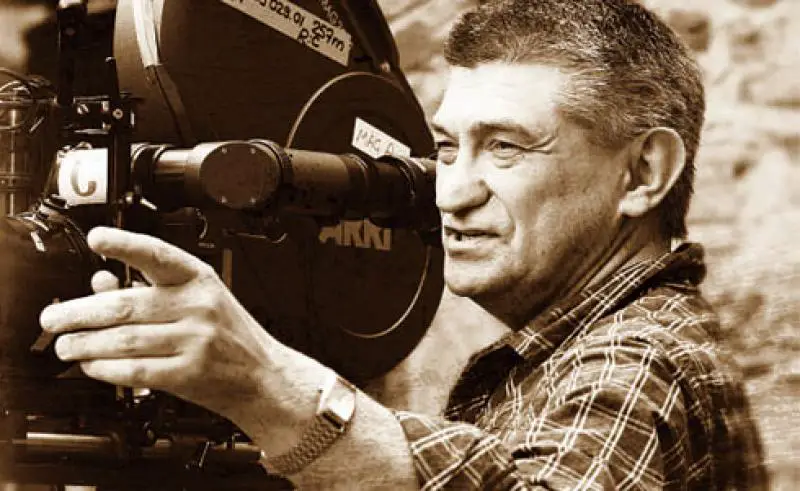In Confession [Povinnost’, 1998] Russian director Aleksandr Sokurov explores the world of post-Soviet naval service in a lengthy, made-for-television documentary. Marked by Sokurov’s distinctive use of painterly cinematography, Confession’s visual qualities distinguish it from typical examples of documentary film. Disavowing conventional narrative structures such as plot, easily comprehensible symbolism, and transparent social commentary, Sokurov constructs a deeply personal vision that challenges the viewer’s patience. How, then, is Confession to be understood? Stepping back from traditional modes of film analysis and deploying analytic strategies more common to the field of art history, Sokurov’s cinematography can be read productively in light of two paradigmatic traditions of image-making: the canon of Western painting from the Renaissance to the Baroque, and the constellation of artistic and spiritual impulses surrounding the Orthodox icon.[1]
Methodology
Precedents exist for this type of analysis. Thus, I will draw upon the methodologies and terminology already established by other authors. First, film scholar and art historian Alexander Nemerov has described the way that repeated frames of imagery interrupt a film’s temporal flow.[2] Sokurov blurs the rhythm of Confession by returning time and time again to images that become recurrent motifs, burdened with meaning. Rather than reading these kinds of images as allegories concealing definitive meaning, I want to use Nemerov’s analysis to understand these scenes as exemplifying the “antinarrative power of stasis,” evoking the pictorial conventions of static art.[3] By lingering on, and repeating certain images, Sokurov asks the viewer to read them as images, halting the flow of the film.
Drawing on Nemerov’s analytic framework, I will closely read two recurrent motifs in Confession. The first, the image of a contemplative conscript, asks exactly what Sokurov’s camera represents—an actor, a character, or an aesthetic signifier? The second, the image of the commander peering out of the battleship’s windows, exemplifies Sokurov’s preoccupation with looking and blindness.
Additionally, film scholar Annette Michelson discusses the “transvaluation of pictorial values,” as present in Dziga Vertov’s Three Songs of Lenin [Tri pesni o Lenine, 1934], arguing that the early Russian film functioned as a modernist extension of the Orthodox icon.[4] Three Songs of Leninconstructs an iconostasis from images, arranging and augmenting documentary recordings of Lenin himself. These fragments of Lenin draw on the themes and conventions of still images, underscoring their relationship to the icon. Using Michelson’s analytical techniques, I will argue that the icon’s process of mediation provides a key to understanding the ontological function of these motifs in Confession.
By applying these methodologies to Sokurov’s film, I hope to come to a deeper understanding of the film and its objectives.
The Conscript
The term “documentary film” generally refers to a non-fiction film characterized by some sort of “creative shaping” of the reality it records.[5] Set on a Russian battleship, Confession is a documentary that follows young recruits, seasoned sailors, and their melancholy captain around the Arctic Circle. Sokurov breaks the film into five parts of fifty-two minutes to fit a television-broadcasting schedule. The parts are organized thematically rather than according to any teleological sequence. The fourth part, in which the first motif of my analysis is repeated several times, follows a group of new recruits, unused to the hardship of service at sea, and opens with the conscripts huddling together in the ship’s hold. Tired, hungry, and sick of travel, they sit in near total darkness before being ushered into cursory medical examinations.
Surrounded by the bowed heads and contemplative faces of his comrades, a conscript gazes off-camera, his hands clasped before him in a gesture reminiscent of prayer (Figure 1). Like his fellow conscripts, he has close-cropped dark hair, clean-shaven cheeks, and a youthful, masculine countenance. Like them, he huddles in a heavy overcoat. In the hold’s darkness, a single shaft of light illuminates the conscript, visually arresting the frame.
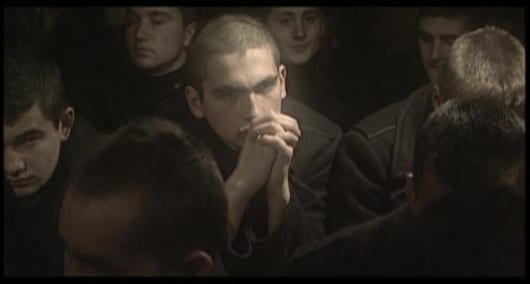
Sokurov, who has asserted in an interview that “the film image must be created according to the canons of painting,” thus uses theatrical lighting and a geometrically arresting composition to emphasize the image as a singular moment.[6] Formally, he invokes the violent chiaroscuro popularized by the Italian Baroque artist Caravaggio, who used light to endow dramatically staged paintings with metaphysical meaning. Sokurov employs similar methods of lighting and composition to transfigure the conscript into a locus of meaning through a strategy of aesthetics.
The Calling of Saint Matthew (Figure 2) supports this comparison and exemplifies the hallmarks of Caravaggio’s art. A strong beam of light illuminates a dark room, singling out the future apostle Matthew. The light picks out the details of Matthew’s spiritual squalor as he gambles and greedily counts his winnings, paradoxically prefiguring his sanctification and laying bare his faults. A manifestation of divine omniscience, the light both reveals and transforms, distinguishing Matthew from his companions.
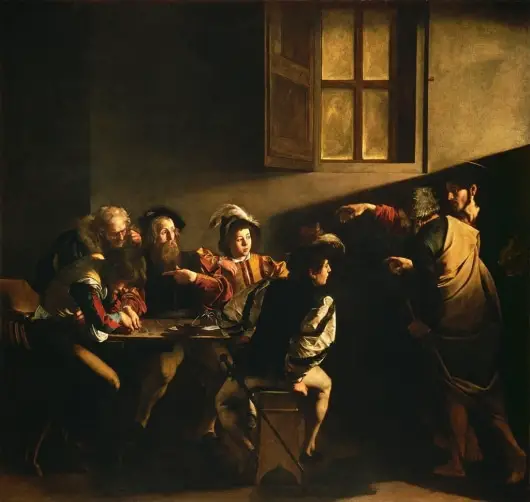
Similarly, Sokurov deploys this recurrent image of a frozen conscript to mark a point of transformation. In a concerted effort to break the wall of the image’s autonomy, both Caravaggio and Sokurov use these moments of transformation to dramatize their authorial presence. Caravaggio often inserted self-reflexive moments into his paintings, slipping his own face into works and underscoring the theatricality of his compositions with plain backgrounds and harsh, contrived lighting. Similarly, a figure to the left of the Sokurov’s conscript gazes steadfastly at the camera. Film scholar Laura Rascaroli has described Sokurov himself as the “point of origin and of constant reference” in his documentaries, noting that the director consistently pares away the trappings of objectivity.[7] His framing of the conscript thus borrows stylistic conventions from the artists of the Baroque in order to cultivate an aesthetic of subjective experience, translating the pictorial elements of lighting and composition into a statement of filmic self-awareness.
Acknowledging his debt to another Old Master, Rembrandt van Rijn, Sokoruv enthuses that he could “bathe… endlessly” in the craft and artistry of painting.[8] Nevertheless, his relationship with the painting tradition goes beyond a simple appropriation of visual elements. He states, “I was always driven by visual aesthetics, aesthetics which connected to the spirituality of man,” drawing an explicit connection between the visual and the metaphysical, and the ability for images to affect the condition of the soul: whether to uplift or depress it.[9] Put simply, he pours meaning into the manner in which he depicts his subjects. How does he construct this meaning, and what are the ramifications for the reading of his films?
In an early scene in Confession, sailors come and go in the fog, (figure 3, below) dissolving into the driven snow while the ship’s commander muses, “what era are you from?” Confession turns on the existential theme of alienation, reinforced by an unforgiving landscape and the ship’s isolation, setting its characters adrift in space and time. As the ship’s commander, an actor whose thoughts are narrated by Sokurov himself, ponders questions of collective experience and shared suffering, a point of tension emerges. Pitting the individual’s image against communal movements of service (“service” is a more accurate translation of the film’s Russian title, Povinnost’) and standardized behavior, the hallmarks of military life, the film complicates any sense of identification with most of its protagonists by continually embedding them into a sea of similar characters which can make indentifying the characters difficult, much less identifying with them.
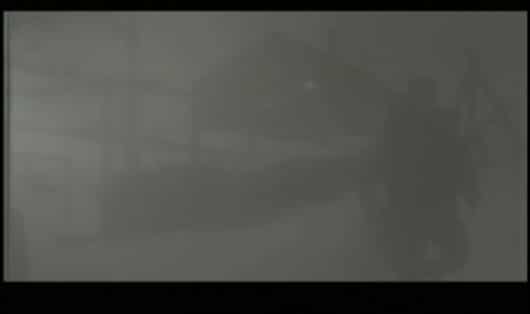
Sokurov’s frozen images make meaning and take “coherent form,” as Nemerov puts it, if read in relation to the Orthodox icon.[10] The icon serves as a locus in which deeply-felt anxieties about separation and communication converge. Sokurov has called Orthodox icons “the most brilliant examples” of Russian artistic practice, indicating that they are likely a source of inspiration to him and strengthening an argument for using them as a point of reference for understanding the ontological structure of Confession.[11]
Art historian Oleg Tarasov has detailed key qualities of the Russian icon, including “the simultaneous representation of different sides of the object.”[12] A strategy of depiction that shifts the object beyond the readily observable, simultaneous representation signifies an augmentation of meaning. Sokurov surrounds his conscript with similar figures; standardized, uniform, they can be read as aspects of the same social body. Indeed, the film treats the conscripts as equal participants of an impersonal process. All the conscripts undergo medical examinations, sleep together, eat together, and work in quotidian shifts. The illuminated conscript (figure 1) represents the sum of conscripts past and present, undistinguishable by “era,” a metonymic picturing of raw material. The suffering engendered by military service works universally, its harshness tempered by its lack of selectivity.
Repeated, contemplated, the illuminated conscript can be read according to the icon’s logic of meaning that treats the exterior as symptomatic or topographic. While iconophilic apologists like Theodore Abū Qurrah and St. John Damascene argued that icons represented rather than manifested divine presence, popular usage contradicted their complex arguments.[13] Gilles Deleuze, for instance, finds that the “purely optical” qualities of the icon produced divine essence in an investigation that lays bare the icon’s power to make the divine literally present on the mortal plane.[14] The attention paid to the icon’s surface, its qualities of color and contour, framing and reflectivity, transformed it into a space that paradoxically constructed divinity while manifesting the direct expression of a divine referent. Most significantly, the icon’s surface details map the world of divine. They provide visual access to a timeless space of angels, saints, and other ineffable beings. The icon’s details manifest a kind of volume that stretches behind the picture plane.
Philosopher Thorsten Botz-Bornstein has already pointed out the similarity between this mode of approach and Sokurov’s cinematography.[15] In this fashion, the conscript’s face, his body, his clothes become burdened with meaning. In line with Nemerov’s analysis of still images in early Hollywood horror films, this meaning is far from allegorical. Rather, returning to Sokurov’s position as the “point of origin” of the film, the volumetric meaning behind the conscript stems from the director’s construction of a subjective aesthetic. Describing a relationship with two actors with whom he particularly enjoyed working, Sokurov recalls that “it is first of all very important to embody an idea. They go so far as to forget their own selves.”[16] Transfiguring the man he films into “the faithful expression of a truth of his existence,” Sokurov aestheticizes the conscript as the manifestation of something beneath the surface.[17] Sokurov attempts to efface the actor, his camera draining the actor of individuality and re-materializing him as a subjective expression of a filmic reality.
The recurring conscript marks the resurfacing of a fragment, one of many in both the film and the ship’s microcosmic world. The ship’s internal hierarchy, a constructed and self-conscious system, locates transformative power in exteriority and controlled perception. Cultivating a highly artificial reality from the ground-up, the ship surrounds conscripts with role models and re-fashions them from the outside-in. Oleg Tarasov discusses this ontological strategy, as developed in the icon’s structured world:
…when a person surrounds him- or herself with icons in the quite literal sense, a reverse mirror effect can easily arise: reality itself can be subordinated in one’s consciousness to the sacral mode, and so can appear more authentic than it is.[18]
Sokurov shifts his attention from the ship’s ostensible purpose of safeguarding Russia’s borders to the “subordinating” of consciousness. The commander laments his own uselessness in relation to his nineteenth-century counterparts, feeling that Russia’s abandonment of imperial ambition has stripped military service of its relevancy. Frederic Jameson observes that “the daily routine of the Arctic Fleet is the very paradigm of a repetitive temporality in which nothing happens.”[19] Lacking military urgency, the ship becomes a self-contained entity, perpetuating its own rhythms of existence, “appearing more authentic than it is” and slowly working through the same “reverse mirror effect” that Tarasov describes.
Nicephorus the Patriarch of Constantinople, who wrote extensively on images, argued that the icon renders clear the parameters of infinity,[20] while Saint Symeon the New Theologian described God’s creation of a fence around the world as a positive activity that concentrated the divine.[21] Both theologians describe a paradoxical bounding of the infinite. Similarly, Sokurov portrays the battleship setting of Confession as possessing a limitless capacity to rework humanity through the experience of service. The commander explains his unease with the realization that “what terrified him was not becoming old, but that his ship did not become old, the sea was not old, the air around was not young.”
Cultivating an environment of service that transcends space and time, resonating with models of bounded infinity, the ship itself borrows the icon’s ability to access otherwise-inaccessible arenas. The illuminated conscript, frozen by Sokurov’s camera, thus embodies the workings of the ship’s “sacral mode.”
The Commander
A second recurrent motif, the watching commander, inverts the conscript’s passive receptivity. Struggling for self-awareness, the commander is an anomalous character in Confession. Unlike the singled-out conscript, the image of the watching commander contains the seeds of self-awareness but not of self-sufficiency. Recurring as both a prominent theme and a repeated image, the watching commander becomes a vehicle for Sokurov’s reflections on looking and blindness.
The commander’s reflections on history, literature, and service crystallize in a scene of the commander alone in the ship’s tower, surrounded by navigational instruments and gazing at the night through large windows and driven snow (figure 4). Shielded from the elements, he stands in sharp contrast to the conscripts who wrestle with the landscape’s material conditions, hauling coal and thawing ice. This particular image recurs throughout the documentary, marking the commander as a quintessential observer who apprehends the world through vision rather than physical work.
The commander is anomalous in his freedom to look out, beyond the parameters of the ship and service. He is aware of the ship’s drift through time and space, exemplified by the movement through the arctic landscapes. Sokurov sets Confession amid a spectacular interplay of snowy crags and storm-tossed waves, a nod to the Romantic landscapes of Caspar David Friedrich that underscores a location of the sublime in nature.[22] The Romantic landscape, with its ability to overwhelm and overawe, threatens the artificially constructed world of the ship and its military structure. As the conscripts huddle in the hold, the commander muses, “…it’s good the conscripts don’t see these landscapes,” landscapes that dramatize hardship and the unforgiving consequences of work. Indeed, the young sailors must acclimatize themselves to the ship’s interior before taking in the surrounding landscapes. Beginning in the bowels of the ship, the conscripts move outside gradually, concluding their work in an arctic settlement at the documentary’s end.
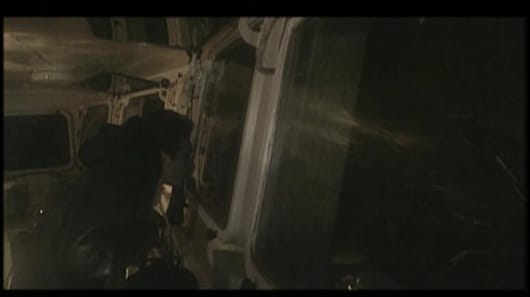
Looking beyond the ship becomes a privilege, a way of placing the ship’s hermetic world in a larger context. Nevertheless, the recurrent motif of the commander and his gaze emphasizes the inadequacy of the ability to look out. The commander strains in his looking, hunched over and peering into the dark of night.
The vocalization of his thoughts, voiced by Sokurov himself, confirms that he is trying to grasp something that he cannot. The commander’s narrated thoughts become an “eminently personal” discourse that borders on the diaristic.[23] Wandering unseen among the crew, his reflective and longwinded monologue mixes philosophical observations with self-doubt and commentary on the crew’s activities. He is revealed as a man who is both unsure of what he sees and insecure in his role as commander; the commander’s gaze becomes a device that lays bare a form of blindness.
Blindness, or compromised looking, is an important theme in many of Sokurov’s films. In his analysis of Sokurov’s Father and Son [Otets i syn, 2003] film scholar José Alaniz describes “a complex economy of surveillance” in which various types of looking inflect the relationships between characters.[24] One character’s oblique gaze, directed away from the camera—a “roaming” gaze—both unlocks her from the film’s insular sphere and excludes her from the trust of the all-consuming world of the two protagonists. Sokurov’s The Second Circle [Krug vtoroi, 1990] features a son whose fascination with his father’s corpse reaches a climax when he pulls back the corpse’s eyelids to marvel at his dead father’s lack of sight. The film scholar Mikhail Iampolski has described The Second Circle in terms of “blind zones.”[25]
The commander’s blindness thus becomes a key to understanding how the ship’s “sacral mode” extends to Confession’s filmic structure. Sokurov turns the commander’s blindness into a paradigmatic mode of representation, positing “…ideally, the filmmaker would never allow the viewer to comprehend or even perceive the image, at once, in its entirety.”[26] Offering the viewer fragments, in flux, Sokurov engages the icon’s ontological potential. Music, narration, and movement amplify the two motifs analyzed above. Endowed with what Michelson describes as the “glint in the pupil of the eye which confers light and, through light, movement,”[27] invoking the icon’s “semblance of life,” these still images establish their weight through a re-immersion in Confession’s larger structure.[28]
Conclusion
The frozen, recurring images of the conscript and the commander act as nexus points around which the temporally-grounded experience of viewing flows. They lodge in the film’s structure, transforming Confession’s aesthetic of subjective vision into a meditation on the activity of looking. Sokurov undermines filmic objectivity to narrow the gap between representation and experience. Contemplating the conscript and the commander, his camera suggests that the iconic promise of direct experience retains its relevancy in the medium of film, and Confessionthus exemplifies what Botz-Bornstein describes as the “inexhaustible” quality of Sokurov’s images.[29] Enriched by their duration, these images describe a particular intersection between the painterly and filmic and suggest a new, aesthetically grounded, model for filmic representation.
Works cited
Abū Qurrah, Theodore. A Treatise on the Veneration of the Holy Icons. Translated and edited by Sidney H. Griffith. Louvain: Peeters, 1997.
Alaniz, José. “Vision and Blindness in Sokurov’s Father and Son.” In Cinepaternity: Fathers and Sons in Soviet and Post-Soviet Film, ed. Helena Goscilo and Yana Hashamova, 282-309. Bloomington: Indiana University Press, 2010.
Botz-Bornstein, Thorsten. Films and Dreams: Tarkovsky, Bergman, Sokurov, Kubrick, and Wong Kar-wai. Lanham: Lexington Books, 2007.
Deleuze, Gilles. “Painters Recapitulate the History of Painting in Their Own Way.” In Francis Bacon: The Logic of Sensation, trans. Daniel W. Smith, 99-108. Minneapolis: University of Minnesota Press, 2002.
Galetski, Kirill. “The Foundations of Film Art: An Interview with Alexander Sokurov.” Cineaste26.3 (2001): 4-8.
Grigg, Robert. “Byzantine Credulity as an Impediment to Antiquarianism.” Gesta 26.1 (1987).
Iampolski, Mikhail, “Death in Cinema.” Translated by Anesa Miller-Pogacar, Ludmila Zebrina Pruner, and Allison H. Hall. In Re-Entering the Sign: Articulating New Russian Culture, edited by Ellen E. Berry and Anesa Miller-Pogacar, 270-288. Ann Arbor: University of Michigan Press, 1995.
Jameson, Frederic. “History and Elegy in Sokurov.” Critical Inquiry 33.1 (Autumn, 2006): 1-12.
Michelson, Annette. “The Kinetic Icon in the Work of Mourning: Prolegomena to the Analysis of a Textual System.” October 52 (Spring, 1990): 16-39.
Nemerov, Alexander. Icons of Grief: Val Lewton’s Home Front Pictures. Berkeley: University of California Press, 2005.
Nicephorus the Patriarch. “Antirrhetic II.” Translated by Anna Cancogne. In Fragments For a History of the Human Body: Part One. Edited by Michael Feher, 156-159. New York: Zone, 1989.
Platinga, Carl. “Documentary.” In The Routledge Companion to Philosophy and Film. Edited by Paisley Livingston and Carl Platinga, 494-504. London: Routledge, 2009.
Rascaroli, Laura. The Personal Camera: Subjective Cinema and the Essay Film. London: Wallflower Press, 2009.
Schrader, Paul. “The History of an Artist’s Soul is a Very Sad History: Aleksandr Sokurov interviewed by Paul Schrader.” Film Comment 33.6 (Nov/Dec. 1997): 20-25.
Sedofsky, Lauren. “Plane Songs: Lauren Sedofsky talks with Alexander Sokurov.” Artforum International No. 3 (November 2001): 124-128.
Sokurov, Alexander. “The Old Masters.” Additional DVD material on Elegy of a Voyage (2001).
Symeon the New Theologian, Saint. On the Mystical Life: The Ethical Discourses, Vol. 1. Translated by Alexander Golitzin. Crestwood: St. Vladimir’s Seminary Press, 1995.
Szaniawski, Jeremi. “Interview with Alexander Sokurov.” Translated by Jeremi Szaniawski. Critical Inquiry 33.1 (Autumn, 1996): 13-27.
Tarasov, Oleg. Icon and Devotion: Sacred Spaces in Imperial Russia. London: Reaktion Books, 2002.
Footnotes
[19] Frederic Jameson, “History and Elegy in Sokurov,” 6.


